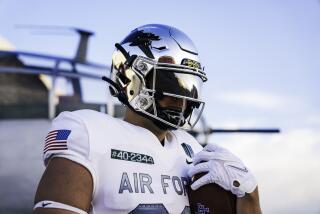Doolittle’s Raiders Will Say Another Goodbye
- Share via
Nobody knows who finally will drink the aging cognac.
All that’s certain is that the surviving Doolittle’s Raiders are old men now. The legendary World War II outfit has shrunk from 80 to 26. Eventually, the 26 will shrink to just two--and it will be those two who open the old bottle of cognac to toast their fallen comrades.
Howard Sessler won’t be in the final pair. A retired contractor who lived in Moorpark, he died last month at 83.
From time to time, Sessler attended the Raiders’ annual reunions. At each, the men recall training for the secret mission that was ordered by FDR just two weeks after Pearl Harbor. They speak reverently about their leader, the flamboyant flying ace Jimmy Doolittle. They reminisce about the overloaded B-25s they had to pilot 2,000 miles to Japan from the deck of an aircraft carrier. They talk about what it’s like to be 19 or 20 and suddenly a part of history.
“We were young and we didn’t really give a damn,” Sessler once told a reporter. “We weren’t scared. Nobody knew what it was to be shot at. It was just like a sport--like football or basketball.”
Four months after the devastation at Pearl Harbor, Doolittle’s Raiders bombed targets in five Japanese cities. With just 16 planes, they didn’t inflict great damage, but the attack cheered a demoralized American public and shocked the Japanese. Some historians say it pushed them prematurely into the Battle of Midway, a naval disaster from which they never recovered.
“It was a psychological raid,” said C.V. Glines, a retired colonel who has written several histories of the Raiders. “FDR wanted some real effort to show the Japanese that we could and would fight back.”
Ditching into the sea off the China coast, bombardier Sessler and his three buddies weren’t thinking about the historic implications of the bombs they had dropped. With their life raft punctured on an airplane part and a storm swirling around them, Sessler swam for an island a mile off.
“Sess was an excellent swimmer,” recalled Edward Saylor, his flight engineer. “He was a first-class guy, all around.”
On the rocky atoll, the men reunited. A villager led them to a Buddhist temple, where they crouched in a secret cellar as Japanese soldiers beat a monk who had helped them. Hiding under tarps in a fishing boat, they eventually made their way to China, where they outmaneuvered Japanese patrols for weeks until they reached safety.
Seven of the Raiders died, including three executed by the Japanese. Five were sent to prison camps in the Soviet Union.
“It was just a war mission,” said Saylor, a retired Air Force officer. “That’s all. We survived it, and then went on.”
Sessler went on to fly more than 100 missions over North Africa and Italy.
Like so many in his generation, he didn’t crow about his wartime achievements.
“He thought he had something to do, and that was it,” said Anna Bell Sessler, his wife of 37 years. “The job was there and they got it done.”
But there was more to being one of Doolittle’s Raiders than a checklist of tasks accomplished.
In May, the men will meet in Fresno. As at all their reunions, 80 silver goblets, each inscribed with a man’s name, will be transported under guard from the U.S. Air Force Academy in Colorado Springs.
In a somber ceremony, Sessler’s goblet will be inverted--the custom that honors those who have died. The survivors will sip wine to toast him. The cognac will remain unopened, even though it isn’t the original bottle. The original, which dated from 1893, the year of Doolittle’s birth, disappeared at the Air Force Academy.
At one reunion, Glines, the group’s historian, was pensively viewing the goblets with Jimmy Doolittle.
“I wonder who the last two will be,” Glines said.
“I wonder who the other guy will be,” the general responded.
Doolittle died eight years ago at the age of 96.
*
Steve Chawkins can be reached at steve.chawkins@latimes.com or at 653-7561.



